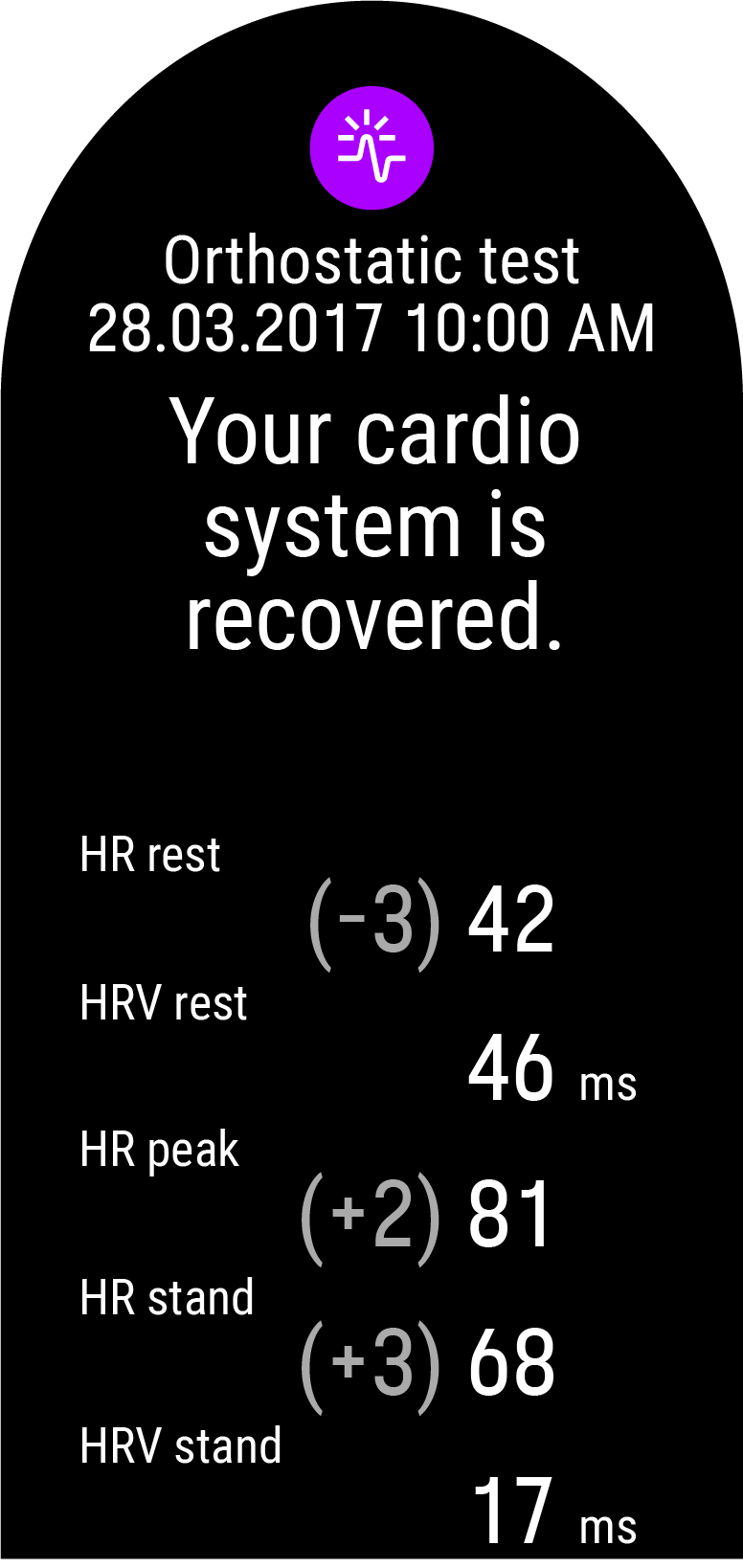Orthostatic Test with Grit X Pro/Vantage V/Vantage V2
The Orthostatic test is a generally used tool for monitoring the balance between training and recovery. It allows you to track how your body responds to training. In addition to training induced changes, there are many other factors that can affect your Orthostatic test results, such as mental stress, sleep, latent illness and environmental changes (temperature, altitude) to mention a few.
The test is based on measuring heart rate and heart rate variability. Changes in heart rate and heart rate variability reflect changes in the autonomic regulation of the heart.
Performing the test
For the Orthostatic test, you need to use a Polar H9/H10 heart rate sensor (an H6 or H7 heart rate sensor can also be used if you have one). The test lasts for four minutes, and to make sure that your results are as reliable as possible, you need to perform the test in similar conditions every time – we recommend that you take the test in the morning before breakfast. Do the test regularly to establish your individual baseline. Sudden deviations from your averages could signify that something is off-balance. See the instructions below:
- Wear the heart rate sensor with the strap. Moisten the electrode area of the strap and wear the strap snugly around your chest.
- You should be relaxed and calm.
- There should be no disturbing noises (for example, television, radio or telephone) or other people talking to you.
- It is recommended to perform the test regularly and at the same time of day in the morning after waking up to get comparable test results.
On your watch, choose Orthostatic test > Start the test with HR sensor. The watch starts searching for your heart rate. When your heart rate is found Lie down & relax is shown on the display.
- You can be seated in a relaxed position or lying in bed. The position should always be the same when you do the test.
- Do not move during this first part of the test, which lasts for two minutes.
- After two minutes, the watch will beep and Stand up is displayed. Stand up and remain standing for another two minutes until the watch will beeps again, and the test is finished.
You can interrupt the test in any phase by pressing BACK. Test canceled is then displayed.
If your watch cannot receive your heart rate signal, Test failed is displayed. In which case, you should check that the heart rate sensor electrodes are wet, and that the textile strap fits snugly.
Test results
The test gives you five different heart rate and heart rate variability values. These are:
- HR rest: Average heart rate when lying down
- HRV rest (RMSSD rest): Heart rate variability when lying down
- HR peak: This is the one highest heartbeat that occurs after you stand up.
- HR stand: Average heart rate when standing still.
- HRV stand (RMSSD stand): Heart rate variability when standing still
View your latest test result on your watch in Orthostatic test > Latest results. Only your most recent result is shown, and only your first successful test for the day is taken into account as a part of Recovery Pro. The difference of your HR rest, HR peak and HR stand values to your averages are shown in parentheses next to your latest result.

When you’ve performed at least two Orthostatic tests during 28-day period, you’ll get feedback on your cardio system’s recovery on your watch after the test. The feedback is based on your heart rate variability values compared to population norms.
After performing at least four tests in a 28-day period your latest Orthostatic test result is compared to your individual normal heart rate variability (RMMS) range. Your normal range is calculated from the standard deviation of the test results from the past 4 weeks. As heart rate variability values are very individual, the accuracy of the test result becomes more accurate the more measurements are done.
For a visual analysis of your Orthostatic test results, go to the Flow web service and choose the test from your Diary to view details from it. You can also follow your test results in the long-term and spot any deviations from your baseline.

Orthostatic test with Recovery Pro
The Orthostatic test is also an integral part of the Recovery Pro feature in Grit X Pro/Vantage V/Vantage V2 that tells if your cardiovascular system is recovered or not. It compares your Orthostatic test results to your baseline gathered over time, and also takes into account your subjective recovery, as well as your long-term training history.
Learn more about Recovery Pro